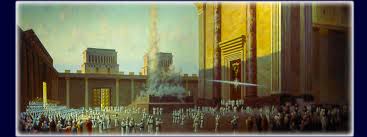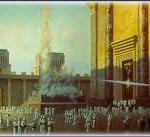The Torah uses a series of almost poetic metaphors to describe the daily Tamid offering:
“Be careful to offer My offering — My bread-offering, My fire-offering, My appeasing fragrance — in its proper time.” (Num. 28:2)
What is the significance of these four descriptions: offering, bread, fire, and fragrance?
Four Characteristics
These descriptions correspond to four fundamental characteristics that are common to all Temple offerings. Yet they are particularly relevant to the Tamid, as this communal offering aspires to integrate holiness into the nation’s daily life.
“My offering.” In Hebrew, korbani. The word korban comes from the root karov, meaning ‘close’ or ‘near.’ Temple offerings are an expression of the soul’s underlying yearnings to draw close to God in all aspects of life. The Tamid offering, representing the entire people, expresses these yearnings in the soul of the nation.
“My bread.” In Hebrew, lachmi. The Temple service reveals the inner harmony between the nation’s material and spiritual realms. Why does the Torah use the metaphor of bread? Bread has the remarkable ability to bind the soul to the body and its physical powers. The Hebrew root lechem also means ‘to solder’ together. The offerings are a kind of Divine ‘bread,’ cultivating the connection between the nation’s natural and holy qualities.
“My fire-offering.” In Hebrew, ishi. Fire is a source of tremendous energy, capable of igniting and activating physical matter. Offerings reflect the fundamental truth that the Divine aspect of the nation’s soul is not limited to the intellectual and emotive spheres, but is also expressed in the physical realm.
“My appeasing fragrance.” In Hebrew, rei’ach nichochi. The Temple offerings foster a sense of pleasantness and sweetness, both for the individual and the nation as a whole. This sweetness is a result of Israel’s special connection to God and the nation’s corresponding lifestyle of holiness and meaning.
(adapted from Olat Re’iyah vol. I, pp. 128-129)
Copyright © 2006 by Chanan Morrison

